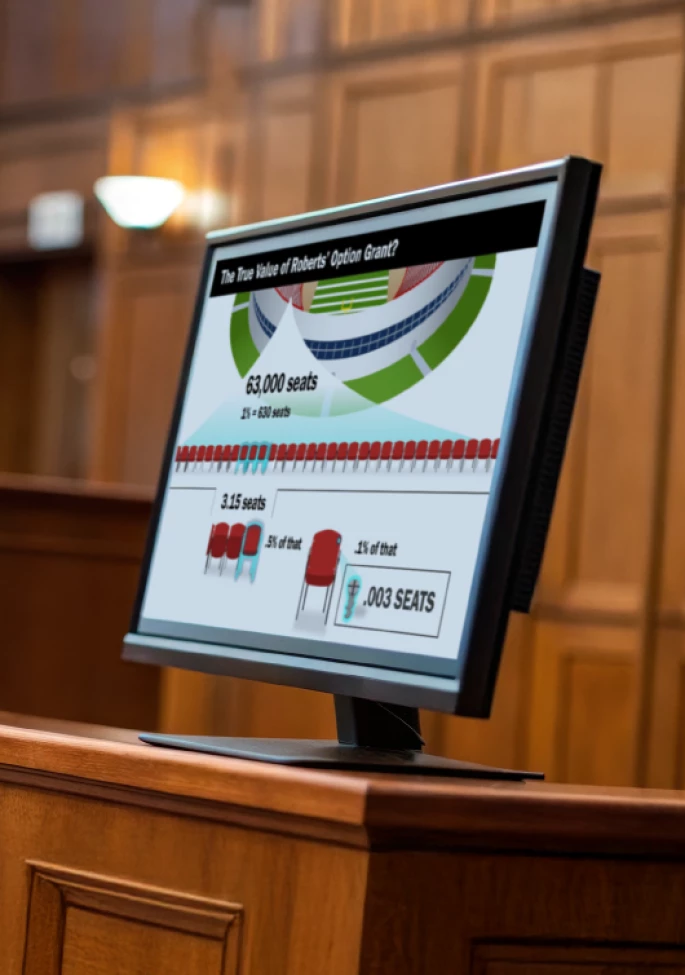You know how to frame a great closing argument. You know how to deliver it to a jury. But in our experience, the real hurdle arises when you take that great argument and great delivery and try to incorporate technology (which you certainly should).
With juries these days, you need to channel a Steve Jobs product launch as much as a Perry Mason trial. Yet, in doing so, you introduce potentially unpracticed skills and tools while placing your reliance on an extra variable—the tech itself. Including a visual presentation will therefore change the way you should prepare and rehearse your closing argument.
Think about Jobs revealing a brand-new product. The cadence was so smooth, and the technology so perfectly integrated, that man and technology seemed to blend seamlessly into the perfect presenting entity. So, now that you have simplified, tightened, and wordsmithed for hours, it is time to make special graphical adaptations to your closing argument presentation.
Preparing Your Closing Slides
When putting together your closing argument slide deck, we recommend sticking to these basic rules:
Emphasize Images
Use images primarily to refresh the jury’s memory and focus their attention on key evidence and testimony. Do not be content to simply show the graphics; closing is when you can have the last word on them yourself—using your rhetoric to reiterate main points, make additional connections, and add additional emphasis. Be prepared to fully elaborate in your own words.
Trim the Text
Text should be used sparingly in closing argument slides. Jurors’ eyes will be drawn to the text, and they will be tempted to read ahead. That is, they will not be paying as much attention to you. You are there to explain why the images are so important. If you want to use text to drive certain points home, try to reveal them one point at a time.
Refresh & Remind
In complex litigation and highly technical cases, you should always include a refresher slide in your closing argument presentation that defines some of the jargon or terms of art.
Check Your Tech
Be sure to double- and triple-check your presentation technology. It has to work flawlessly so you can too. At every stage of the rehearsal process, and especially during the real thing, you should also keep a full, hard-copy printout of your script close at hand. Even triple-checked, technology is a fickle beast. It is never redundant to have a backup plan.
Rehearsing Your Closing Argument
Here are the four main steps to getting that closing presentation—complete with visuals—down cold before you enter the courtroom.
Step 1: Memorize the Details
Some successful speakers like to write or type out their entire presentation, verbatim, as they are initially learning their slide deck. It’s a common actors’ trick for learning lines. Doing so once (or preferably more) helps the information settle more firmly in your memory.
Step 2: Integrate Your Slides
With a printout of your script next to your laptop, walk through all of your slides. Look for the places in your script to drop in the slide references, and then adjust your script (and/or the slide order) as necessary until the presentation feels smooth and natural.
Be sure to identify slide references by number in your script and keep the slide numbers onscreen as well. This will make it easier to navigate if you decide to jump around or skip sections of your script in response to your opponent’s closing.
Step 3: Watch the Time
Nothing drains the power of a closing argument like running out of time before you are finished. The first rule of time management is one minute per slide. If you have 45 minutes to present and 80 slides in your deck, you will never have enough time. Some attorneys still keep 80 slides and then assume they can wrap up anywhere when they run out of time—they cannot.
The safest strategy is to plan for fewer slides than you have minutes and to plan that your presentation in court will take about one-third longer than it runs in practice. Just remember, closing is for your hardest-hitting arguments; trimming the fat will not just keep you on time, it will make each point more resonant.
Step 4: Rehearse for Real
Practice again with your presentation on a projector/screen in the war room or your conference room. Try to simulate the courtroom environment as closely as possible; know where you will look for the judge, the jury, your client, and your opponent. If you will have a podium at trial, use one in rehearsal.
Do an additional one or two dress rehearsals in front of your trial team and, if possible, the client. You should present the entire closing argument first without any interruptions, and then walk through the slides one-by-one with your team to edit and tweak the language, transitions, etc. You or a colleague might also discover that lines in your script that looked great on paper do not sound quite right spoken aloud. An additional option is to present before a representative group of mock jurors; indeed, this is one of the very best ways to learn what works and what does not with your closing—jurors are your target audience, after all.
While a live audience is ideal, you (or a consultant) can also videotape your presentation as necessary so that others may watch and critique it. This gives you the flexibility to get input from multiple groups of people. However you practice, keep practicing until you become familiar enough that you do not even have to look at the slides to present their content.
Using Technology in Closing
Preview Monitors
To avoid having to look back at the screen—and therefore away from the jury—during your presentation, we recommend having a preview monitor in front of you. This allows you to maintain eye contact with jurors during your entire presentation. It also allows you to see if they are “getting it.”
Speaker Notes
If (ideally) you do use a preview monitor, an additional benefit is the ability to see your notes on-screen with your presentation. PowerPoint’s “presenter view” appears when you place your laptop in the extended monitor setup, and it displays your notes while you are presenting your slides. The presenter mode also allows you to jump easily to any slide if you need to go out of order.
That being said, you should not try to bounce between the speaker notes and your printed script. It is easy to get lost if you are looking back and forth; pick one or the other and stick with it. (Though as we mentioned before, you should always keep the paper script close by as a foolproof backup just in case the technology fails.)
On-Site Edits & Experts
If you are well-prepared and well-rehearsed, and if you are comfortable moving around in your slide deck, you will be able to adjust your presentation on the fly. This will give you the ability to incorporate rulings made on the morning of closings or, if you are presenting second or getting up on rebuttal, to respond to your opponent without missing a beat. A surefire way to ensure your closing presentation runs smoothly, even with day-of changes, is to work with an experienced trial technician.
Final Thoughts
Ultimately, the best thing you can do is to start preparing your closing argument early, but we know that real life can get in the way of the time you have to rehearse. If you run down to the wire, be sure to focus on your best-of-the-best arguments, edit slides with a critical eye, try to fit in at least one or two live audience run-throughs, and keep a backup script close at hand. When in doubt, partner with trial technology professionals.







